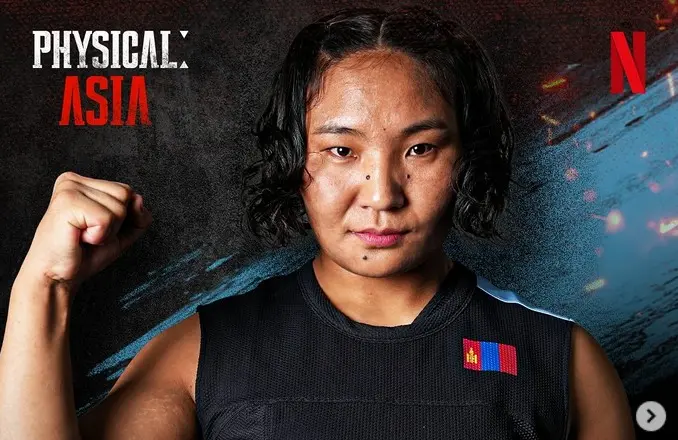Mongolia and South Korea's long-game strategy pays off as Physical: Asia sets up a One-ton Pillar Push Deathmatch
-
 Adiyasuren Amarsaikhan from Team Mongolia, Physical: Asia (Image via Instagram/@amarsaikhan_adiyasuren)
Adiyasuren Amarsaikhan from Team Mongolia, Physical: Asia (Image via Instagram/@amarsaikhan_adiyasuren)Physical: Asia Episode 9 split the competition into two distinct strategies: go all-in to win the Battle Rope Relay or hold back and prepare for the looming elimination match.
Mongolia and South Korea became the standout examples of the latter.
While Australia and Japan deployed their strongest competitors immediately, Mongolia and South Korea recognized a deeper game unfolding as soon as the Master announced,
“Only one teammate can compete at a time… the number of participants allowed will be limited to three.”
That rule changed everything.
The strategy twist that redefined Physical: Asia Episode 9
As players examined the ropes, Australia reacted with confidence and Japan mirrored their approach. Meanwhile, Mongolia hesitated — not out of fear, but insight.
When the Master revealed that only the winner of the relay would advance directly, while the other three teams would have to compete again, Mongolia saw the trap.
When the teams were strategizing, Orkhonbayar read the situation moments after learning that only half the team could compete. He said,
“I think Australia’s banking on their big guys. They’re trying to win as fast as possible.”
Their conclusion was strategic, not emotional: save the heavy hitters.
Adiyasuriyen intervened,
“But it’s a poor strategy. There’s a 75 percent chance we’ll be up for elimination. We need to prepare for that. We shouldn’t just put all our strongest in this game.”
Mongolia confirmed their lineup, saving the most powerful members for whatever twist the show would unleash next.
Adiyasuriyen said,
“Remember, they’re trying to take the lazy way out. But we know better. You’ve just gotta be patient.”
Adiyasuren’s elite judo background showed in both her physical ability and her strategic thinking.
Her read of the game helped Mongolia hold back their strongest athletes, allowing the team to enter the Death Match with their top competitors fully preserved.
Meanwhile, Australia stacked their trio.
Korea assumed Round 1 wasn’t theirs to win and preserved their best for later.
Japan, sensing the threat from Australia, fielded their strongest athletes immediately.
Mongolia and South Korea's decision proved pivotal when the Master revealed the second part of Quest 4 — the Death Match.
Japan won the first game of Quest 4 of Physical: Asia.
The captains of the three losing teams stepped forward and opened their mystery boxes to find shackles.
Confusion shifted to dread as the Master declared the challenge:
“The 1,200-kilogram Pillar Push.”
The twist that followed made South Korea and Mongolia’s strategy look prophetic. The master announced,
“Any teammate who was involved in the Battle Rope Relay may not participate.”
Eddie Williams from Australia, who was eager to participate in the deathmatch, reacted first,
“Are you f**** serious? My heart sunk. The thing that I was made for, I couldn’t even do.”
Robert Whittaker said,
“I’m kinda shattered.”
This rule flipped the hierarchy.
Australia, having used its strongest athletes in the relay, suddenly faced the elimination match with a weakened trio.
Korea and Mongolia, who played the long game, were fully loaded.
Katsumi Nakamura said,
“They’ve [Mongolia] got some strong contestants”
Orkhonbayar laid out their confidence,
“Our strategy paid off. We wouldn’t have gotten this far without being careful and strategic.”
The Koreans were relieved, too, as they saved their strongest for later.
Japan’s Hashimoto says,
“Wow, Korea’s strong.”
Dong-hyun said,
“Our plan actually worked. We made the right call. Thank goodness. I can’t even begin to express how relieved I was.”
A flashback showed that Korea had foreseen what was about to come and planned accordingly. They had sensed the “clues”.
Team South Korea entered the Pillar Push with those they considered to be the strongest of the pack — Kim Dong-hyun, Amotti, and Kim Min-jae.
Mongolia also entered the Pillar Push with exactly the trio they wanted: Orkhonbayar, Adiyasuren, and Khandsuren — a combination built for brute strength and endurance.
Their belief in each other was clear.
Dong-hyun says with confidence,
“We’ll come out on top.”
Orkhonbayar declared,
“You and I could do this alone, Adiya. Add Khandsuren, we’re even stronger.”
Australia, however, believed they still had enough stamina to survive. Dom insisted,
“We can take Mongolia, easy.”
The episode ended just as the Death Match began, leaving Mongolia and Korea mid-push with the exact advantage they had preserved themselves for.
Physical: Asia emphasizes not only strength but also foresight.
Mongolia and South Korea may not have won the Battle Rope Relay, but they may have won something more important — a chance to survive.
Stay tuned for more updates.
TOPICS: Physical: Asia, Physical: Asia Team Mongolia, Physical: Asia Death Match, Physical: Asia South Korea, Physical: Asia Team Australia
- Physical: Asia alum Enkh-Orgil Baatarkhuu caps breakout year with ONE Championship Title
- Robyn Brown of Physical: Asia earns SEA Games Silver in women's 400m hurdles
- Physical: Asia star Amotti to lead Lululemon training ground event in Singapore
- How Physical: Asia fueled Enkh-Orgil Baatarkhuu's momentum before his ONE World Title Fight